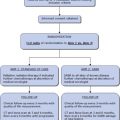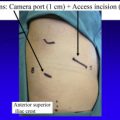Patients with stage I and stage II non–small cell lung cancer undergoing complete resection have a 40% to 70% 5-year overall survival despite optimal local therapy. Chemotherapy administered after complete resection has been shown to improve overall survival at 5 years by approximately 5%. This improvement in survival may be confined to patients with stage IB disease 4 cm or greater, and to those with hilar or mediastinal lymph node involvement. The optimal chemotherapy regimen appears to be cisplatin-based doublet or triplet chemotherapy for 3 to 4 cycles. The addition of biologic agents has failed to improve outcomes.
Key points
- •
Adjuvant chemotherapy administered after complete surgical resection of non–small cell lung cancer results in an absolute survival benefit at 5 years of approximately 5%.
- •
Patient factors, such as comorbidities, life expectancy, and performance status, and tumor characteristics, such as histology, size, surgical margins, and nodal involvement, must be considered when selecting appropriate patients for chemotherapy.
- •
Cisplatin-based combination chemotherapy remains the standard of care for optimizing outcomes in patients with higher risk stage I to stage III non–small cell lung cancer.
Introduction
Patients with surgically resected early-stage non–small cell lung cancer (NSCLC) have a relatively high risk of distant recurrence and death despite optimal surgical outcomes. In the United States, patients with localized disease have a 54.8% 5-year overall survival, whereas those with regional nodal disease have a 27.4% 5-year overall survival.
Administration of systemic cytotoxic chemotherapy to patients with no known residual disease in the postoperative period had been unsuccessful in early clinical trials using single-agent alkylating agents. In 2004 and 2005, 2 trials demonstrated a benefit in survival in a subset of these patients, and further trials and meta-analyses have supported this finding. Identification of patients who derive the most significant improvement from chemotherapy in this setting has required numerous international clinical trials and the pooling of individual patient data into large meta-analyses.
Introduction
Patients with surgically resected early-stage non–small cell lung cancer (NSCLC) have a relatively high risk of distant recurrence and death despite optimal surgical outcomes. In the United States, patients with localized disease have a 54.8% 5-year overall survival, whereas those with regional nodal disease have a 27.4% 5-year overall survival.
Administration of systemic cytotoxic chemotherapy to patients with no known residual disease in the postoperative period had been unsuccessful in early clinical trials using single-agent alkylating agents. In 2004 and 2005, 2 trials demonstrated a benefit in survival in a subset of these patients, and further trials and meta-analyses have supported this finding. Identification of patients who derive the most significant improvement from chemotherapy in this setting has required numerous international clinical trials and the pooling of individual patient data into large meta-analyses.
Patient evaluation overview
When evaluating patients for adjuvant therapy, the oncologist and the patient must weigh the overall benefit of therapy in long-term survival against the risk of complications. Several patient and tumor characteristics require thorough assessment.
Tumor Factors
TNM stage
The features of the resected tumor most critical to that determination are the size of the primary tumor, lymph node involvement, grade of the tumor, and histology. Each of these plays a part in the risk of developing recurrent disease and choice of adjuvant therapy. In patients with negative regional lymph nodes, increasing tumor size and T stage have been shown to be associated with a decrease in long-term survival.
The appropriate use of chemotherapy in patients with negative lymph nodes has been a matter of much debate. Many experts recommend administering adjuvant chemotherapy in patients with a primary tumor greater than or equal to 4 cm based on a survival benefit seen in cancer and leukemia group B (CALGB) 9633. Several retrospective studies suggest there may be a benefit in patients with tumors greater than 2 cm, however. This benefit has not been seen in prospective trials.
Tumor grade and lymphatic/vascular invasion
Higher tumor grade and the presence of lymphatic or vascular invasion may be associated with increased risk of recurrence, and retrospective data indicate that some benefit may exist in treating such patients with chemotherapy.
Histology
NSCLC consists of several different subtypes. Studies of patients with metastatic lung cancer have demonstrated that certain histologic subtypes are more likely to respond to a particular agent. The 2 most common histologies in NSCLC, adenocarcinoma and squamous cell carcinoma, have similar rates of disease recurrence. Patients with metastatic adenocarcinoma seem to benefit from platinum-based doublets using pemetrexed (Alimta), whereas patients with metastatic squamous cell carcinoma benefit more from doublets incorporating gemcitabine (Gemzar). Whether such benefits remain relevant in the adjuvant setting is unclear.
The new International Association for the Study of Lung Cancer/American Thoracic Society/European Respiratory Society classification system further divides adenocarcinoma into histologic patterns. Patients with solid- and micropapillary-predominant lung adenocarcinoma have the poorest prognosis, and these subtypes appear to derive a disease-free survival benefit from adjuvant chemotherapy. Some evidence suggests that lepidic-, acinar-, and papillary-predominant tumors do not show a significant benefit with the addition of adjuvant chemotherapy.
Margin status
The role of adjuvant chemotherapy in patients with positive margins of resection was evaluated in a National Cancer Database review. The investigators found an improvement in 5-year mortality (adjusted hazard ratio 0.75) in patients receiving adjuvant chemotherapy in this setting, regardless of tumor size.
Single biomarkers
The current staging system based on tumor size and pattern of dissemination is inadequate in predicting the expected outcome for individual patients with cancer. A treatment plan that is personalized to identify those deriving the most benefit from adjuvant therapy would be useful to provide justification for or against chemotherapy in the context of the expected complications and risks involved for patients. Recent studies have sought to identify the prognostic and predictive factors related to the genomic characteristics of a tumor that could affect adjuvant and neoadjuvant treatment choices for NSCLC.
The absence or presence of a biomarker can assist in determining the probability of success in adjuvant chemotherapy for patients with cancer. A substudy of the International Adjuvant Lung Cancer (IALT) trial examined Excision repair cross-complementation group 1 (ERCC1) expression in tumor cells. The results indicated that patients who had ERCC1-negative tumors had a longer survival when receiving cisplatin (Platinol)-based chemotherapy versus observation. Patients treated with chemotherapy who displayed ERCC1 expression did not have an advantage. Unfortunately, the reliability of ERCC1 immunohistochemical staining has not been consistent when put into large-scale prospective testing.
NRF2 pathway alterations have been shown to activate the oxidative response pathways in tumors. Using tumor tissue from the JBR.10 trial, patients with a gene expression signature of NRF2 pathway activation, but not those with NRF2 pathway-activating somatic alterations, were found to have a benefit from adjuvant cisplatin and vinorelbine (Navelbine).
Furthermore, p53 and RAS are imperative to cell-cycle regulation, apoptosis, transcription, response to stress, and DNA repair. Patients whose tumors demonstrate p53 protein overexpression, compared with those with low expression, have a shorter survival and appear to benefit from adjuvant chemotherapy. p53 and RAS mutations, however, have not shown utility as a predictive biomarker.
Prognostic signatures and cell-cycle progression biomarkers
As stated elsewhere, the benefit of adjuvant chemotherapy in patients with stage IB NSCLC is uncertain. Efforts to analyze the risk of disease recurrence based on a single gene in lung cancer have largely been disappointing. Multigene panels have proven useful in similar situations in patients with breast cancer, and to a lesser degree in colon and prostate cancer. Similar investigations in lung cancer are in the early testing stage with promising results, although not yet widely accepted.
Microarray profiling of tumors in JBR.10 revealed a 15-gene signature capable of providing prognostic and predictive information. This signature was retrospectively validated in a set of patients including a number with stage IB disease. Prognosis was also accurately predicted in a separate prospective study of patients with stage I disease. A benefit for adjuvant chemotherapy with cisplatin and vinorelbine was seen only in patients with disease characterized by this signature as high risk.
A messenger RNA expression signature of cell-cycle progression (CCP) genes was evaluated by Wistuba and colleagues and was found to be a strong independent predictor of survival in patients with stage I and II lung cancer. Although the CCP score may be useful in determining prognosis and selecting patients at the highest risk of distant recurrence, studies supporting its use as a predictive marker are lacking.
Host Factors
Age
The average age of diagnosis of lung cancer is 70, and 36.7% of patients are 75 years old or older. In elderly patients, chemotherapy is often perceived as carrying an increased risk of morbidity and perhaps mortality. As a result, patients with lung cancer and their physicians often reach the decision not to pursue guideline-based therapies for various reasons. Cisplatin, in particular, may lead to acute and chronic kidney injury, long-term auditory symptoms, and peripheral neuropathy, which are expected to lead to a decreased quality of life. Declines in renal function are not universal in the elderly, however. For some older patients, risking a decline in functional status due to peripheral neuropathy and gait instability or hearing loss does not justify a miniscule improvement in overall survival.
Life expectancy often impacts decisions on adjuvant therapy. For example, a patient unlikely to survive beyond 5 years due to age or comorbidities, such as chronic obstructive pulmonary disease or cardiac disease, would be expected to derive fewer life-years saved from intensive chemotherapy than a younger and healthier patient.
The benefit of adjuvant chemotherapy in an elderly population has been explored in several studies and substudies. The Lung Adjuvant Cisplatin Analysis (LACE) pooled analysis of 5 adjuvant trials explored the role of age on benefit and toxicity with chemotherapy. Notably, only 9% of patients in this analysis were age 70 or beyond, and only 1.3% of patients were older than 75, relatively small numbers compared with those seen in clinical practice in our aging population. This analysis demonstrated that elderly patients more often had initial dose reductions of cisplatin, and that fewer than 60% were able to complete more than half of the planned adjuvant cycles. Patients age 70 or older did not experience an increase in specific or overall toxicity, or in treatment-related death. Whether this surprising outcome is due to more frequent dose reductions or dose omissions in this group is unknown.
The JBR.10 study looked at treatment outcomes in elderly patients, defined as those more than 65 years old. The chemotherapy benefit in elderly patients was similar to that seen in younger patients. Only 23 patients in the study were older than 75 years, however, creating some difficulty in generalizing these results to this population. Toxicity was similar between the young and elderly age groups, although elderly patients received fewer doses of chemotherapy and lower dose intensity. They were also noted to discontinue chemotherapy more often due to refusal.
A recent Surveillance, Epidemiology, and End Results (SEER)-Medicare database analysis evaluated the use of adjuvant chemotherapy in patients older than 65 years of age with T1-2 N1 NSCLC between 1992 and 2006. Chemotherapy was administered to 28.2% of eligible patients. Five-year overall survival was 35.8% in those receiving chemotherapy compared with 28.0% of those not receiving it. The study was limited in that the patients receiving chemotherapy were generally younger and more had received radiation therapy. Other population-based data and the recent Cochrane meta-analysis have shown similar benefits in older patients, although those older than the age of 75 or 80 receiving chemotherapy were not well represented.
Comorbidity and performance status
Comorbid conditions have been shown to impact survival in both early- and late-stage NSCLC. In patients with stage I lung cancer, Karnofsky performance score and the presence of comorbidities independently affected long-term outcomes.
The LACE meta-analysis explored the role of Eastern Cooperative Oncology Group (ECOG) performance status (PS) in patients enrolled in its reviewed trials. Improving PS correlated with an increased benefit of adjuvant chemotherapy. In addition, patients with ECOG PS 2 had a suggestion of a detrimental effect from receipt of chemotherapy. Based on this study and similar findings in the Cochrane meta-analysis, adjuvant chemotherapy cannot be routinely recommended in patients with ECOG PS 2 or greater.
Smoking status
Smoking status also has clear implications on recurrence and survival outcomes in postsurgical patients with early-stage lung cancer. In addition, nicotine modulates mitochondrial signaling, thereby inhibiting chemotherapy-induced apoptosis and possibly rendering chemotherapy less effective. To optimize outcomes, current smokers should be counseled on the importance of tobacco cessation.
Time to adjuvant chemotherapy
The importance of the amount of time between surgery and delivery of adjuvant chemotherapy has been reviewed. A large Canadian series revealed that one-third of patients had a delay of at least 10 weeks, but increased time to surgery did not have an effect on survival. Another recent study of stage II patients receiving adjuvant chemotherapy suggested that time from surgery to delivery of chemotherapy did not influence outcomes, but that the amount of platinum received was a significant factor.
Pharmacologic treatment options
Adjuvant chemotherapy has been evaluated in a series of studies to determine the appropriate patient population and regimen. Combination cisplatin-based chemotherapy has been the most common approach. Individual trials have yielded markedly different results using a wide range of drugs, complicating decisions on chemotherapy for years ( Table 1 ).
| Name of Trial | Stages of NSCLC Involved | Chemotherapy Used | Benefit |
|---|---|---|---|
| ALPI (n = 1209) | Stages I, II, and IIIA | Cisplatin 100 mg/m 2 on day 1 Mitomycin C 8 mg/m 2 on day 1 Vindesine 3 mg/m 2 on day 1 and 8 (every 3 wk for 3 cycles) | 5-y OS benefit 1% (NSS) 5-y PFS benefit 4%(NSS) |
| ANITA (n = 840) | Stages IB–IIIA | Cisplatin 100 mg/m 2 day 1 Vinorelbine 30 mg/m 2 day 1, 8, 15, and 22 (every 4 wk for 4 cycles) | 5-y OS benefit 8.6% 7-y OS benefit 8.4% |
| Big Lung Trial (n = 381) | Stages I–IIIA | Cisplatin 50–80 mg/m 2 Vindesine, vinorelbine, mitomycin/vinblastine, or mitomycin/ifosfamide (every 3 wk for 3 cycles) | 2-y PFS benefit 2% (NSS) 2-y OS benefit not seen |
| CALGB 9633 (n = 344) | Stage IB | Carboplatin AUC 6 Paclitaxel 200 mg/m 2 (every 3 wk for 4 cycles) | 8-y OS benefit 7% (NSS) |
| IALT (n = 1867) | Stages I–III | Cisplatin 80–120 mg/m 2 Vindesine, vinblastine, vinorelbine, or etoposide (every 3–4 wk for 3–4 cycles) | 5-y OS benefit 4.1% 5-y DFS benefit 5.1% |
| JBR.10 (n = 482) | Stages IB, II | Cisplatin 50 mg/m 2 days 1 and 8 Vinorelbine 25 mg/m 2 days 1, 8, 15, and 22 (every 28 d for 4 cycles) | 5-y OS benefit 11% |
Cisplatin-based Adjuvant Chemotherapy
Several individual studies have highlighted the importance of chemotherapy. The IALT study consisted of cisplatin-based adjuvant chemotherapy for stages I to III lung cancer. Different doses of cisplatin were prescribed with either vindesine (Eldesine), vinblastine (Velban), vinorelbine, or etoposide (Etopophos; Toposar) after complete resection. Patients receiving treatment demonstrated an improvement in overall survival of 4.1%. JBR.10 analyzed the overall survival rate of patients as well as the receipt of postoperative adjuvant chemotherapy for stage IB and II NSCLC with cisplatin and vinorelbine. Those receiving adjuvant therapy experienced a greater overall survival, although this benefit appeared to be confined to those with nodal involvement. The Adjuvant Navelbine International Trialist Association (ANITA) trial called for administration of cisplatin and vinorelbine to individuals diagnosed with stage IB to IIIA lung cancer and was consistent with a clinically and statistically significant improvement in overall and progression-free survival.
A few other studies were unable to demonstrate any significant benefit. The Adjuvant Lung Project Italy (ALPI) study treated patients with stages I to IIIA NSCLC with mitomycin (Mutamycin), vindesine, and cisplatin. These results revealed a small and not statistically significant improvement in survival, partly due to low compliance with chemotherapy. The Big Lung Trial enrolled a greater number of patients who were administered various chemotherapy regimens. This study included individuals with stage I to III NSCLC and used various cisplatin-based combination chemotherapy regimens. No survival improvement was identified.
In the absence of clear and consistent signals from the numerous individual adjuvant trials, the LACE and Cochrane meta-analyses pooled patient data across several trials to confirm the overall benefit of adjuvant chemotherapy ( Table 2 ). The LACE meta-analysis was undertaken to assess the efficacy and toxicity of adjuvant chemotherapy and included stages I, II, and III. The results verified that adjuvant chemotherapy improves overall and progression-free survival in patients with stages II and III NSCLC. The power of LACE was insufficient to detect an improvement in survival in stage IB NSCLC.
| Name of Trials | Stages of NSCLC | Number of Patients | Individual Trials | 5-y Survival Benefit |
|---|---|---|---|---|
| LACE | I–III | n = 4584 (radiotherapy planned in 1439) | JBR.10, ALPI, ANITA, IALT, BLT | OS 5.4%; DFS 5.8% |
| Cochrane Lung Cancer Group | I–III | No radiotherapy; n = 8447 Radiotherapy; n = 2660 | 26 trials, including above | OS 4.0% |
Stay updated, free articles. Join our Telegram channel

Full access? Get Clinical Tree






